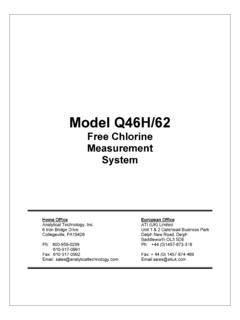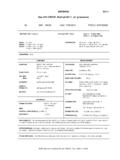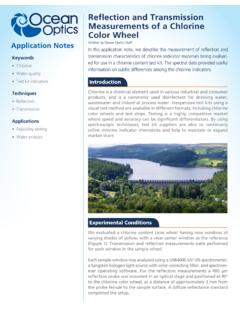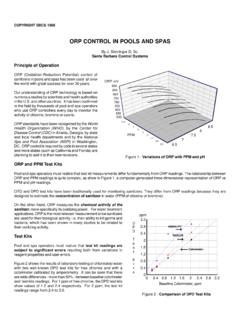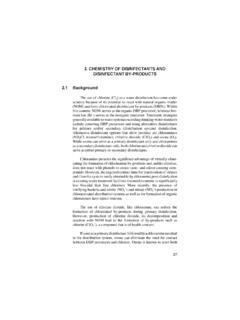Transcription of Controlling/Monitoring Chlorination of Cooling …
1 BACKGROUNDMany manufacturing processes require largeamounts of water to provide Cooling . Most notable ofthese are electric power generation plants for steam,oil refining, and petro-chemical manufacturing. In anyprocess where water is used as a coolant, it cancontain micro-organisms that interfere with the heatexchangers. These micro-organisms tend to attachthemselves to the wall of the heat exchanger tubingforming a layer that decreases the heat transfer effi-ciency. Anothercommon occurrence is the formationof tubercles. These formations create scale on tubewalls andliberate gases (CO2, H2S) which corrodethe tube the Cooling water is sea water, there are otherorganisms present such as hard shelled mollusksthat may attach themselves to equipment and cancause plant shutdowns if caught in rotary has been used to control biologicalcontamination since the 1930 s.
2 To maximize thechlorinator sperformance and to control excesschlorine being returned to the water source, freeresidual chlorine and total chlorine analyzers areused. A typical schematic of a Cooling water systemis shown in Figure free or total chlorine in Cooling waterprovides real time feedback signal for the chlorinationsystem. INSTRUMENTATIONS ince raw water can contain either free chlorine ortotal chlorine , it is important to determine which formof chlorine is present and select the right chlorinemonitoring equipment. Rosemount Analytical has aChlorine Application Questionnaire and a ChlorineMeasurement Selection Guide to assist you (requestform 23-6424).
3 Free chlorine can be measured using the RosemountAnalytical Free chlorine measurement System ModelFCLi, a complete system which includes the chlorinesensor, cable, analyzer Model 1056, and flowcontroller. Additional choices in instrumentationinclude the analyzer Model 54eA. The Model FCLiisavailable in two options: Model FCLi-01 and ModelFCLi-02 with a pH sensor and flow cell. This secondoption is for customers who wish to measure Model FCLidoes not require reagents andavoids the expense and inconvenience of sampleconditioning. Nor does it require an auxiliary pHsensor for pH chlorine can be determined using theRosemount Model TCL. This system is a sampleconditioning and measuring system for the continu-ous determination of total chlorine in water.
4 Theconditioning system continuously pumps bufferedpotassium iodide reagent into the sample. Free andcombined chlorine (total chlorine ) react with potassiumiodide to form an equivalent amount of iodine. Anamperometric sensor measures the concentration ofiodine and sends its signal to the Rosemount DualInput Analyzer Model 1056. The analyzerdisplays theconcentration of total chlorine . Additional choices ininstrumentation include the analyzer Model 54eA,and the two-wire transmitters Model Xmt and Chlorination ofCooling Water TheoryApplication Data SheetADS 43-022 2009 INSTRUMENTATION: FREE chlorine MEASUREMENTFree chlorine Measuring System Model FCLi Complete system includes sensor, connecting cable, analyzer, and flow controller Sensor response is practically independent of pH between and 10 No reagents No auxillary pH electrode Variopol quick-disconnect fittings: makes sensor replacement easyTotal chlorine MeasurementTotal chlorine measurement Model TCL Accurately Measures Total chlorine .
5 0 2 ppm Low Maintenance Design Readily Available Reagent: White Distilled VinegarLasts Two Months: Potassium Iodide in VinegarLow Flow Rate 6 GPD ( GPH or 6mL/Min)Simple Overflow Weir: Correct Flow RateCorrosion Resistant Construction Communication Options: HART, Foundation fieldbus, Alarm/Relays,Alarm/Outputs Choice of Four Instruments: 1056, 54eA, Xmt, 5081 Heavy Duty NEMA 4X(IP65)Membrane Covered Amperometric Sensor No tools required to change membrane Maintenance takes only a few minutes a month Quick sensor cable disconnect, Variopol connectionFIGURE 1 Credit Cards for Purchases right people,the right answers,right Process ManagementLiquid Division2400 Barranca ParkwayIrvine, CA 92606 USATel: (949) 757-8500 Fax: (949) 474-7250 Rosemount Analytical Inc.
6 2009ON-LINE ORDERING NOW AVAILABLE ON OUR WEB subject to change without










